If yes, then keep on reading, because that’s exactly what this article is going to be about!
So… what IS chicharon?
Chicharon (sometimes spelled as tsitsaron) is a versatile and popular snack made from deep-fried, crispy pork rinds. It’s a favorite Pinoy snack that can also be eaten as a pulutan (finger food), or tapas paired with alcoholic beverages. Often, chicharon is savored with spiced vinegar, adding a tangy kick to its crunchy delight.
Some people also use chicharon as a garnish in various Filipino dishes such as pinakbet (vegetable stew) and palabok (a noodle dish you can make with Chef Chona Garcia’s class here at The Bailiwick Academy, Classic Pinoy Favorites).
Aside from the original version made from fried pig skin, there are various types, including premium versions made from pork skin with fat or meat, and regional varieties like chicharon bulaklak (made from ruffle fat) and chicharon bituka (made from intestines). If you’re curious about these varieties, don’t worry; we’ll get to them below!
Origins of Chicharon
What country is chicharron from? Well, it’s believed to have originated in Spain, specifically in the region of Andalusia (like Arroz con Pollo!). The term “chicharron” comes from the Spanish word for pork rind and is believed to be an onomatopoeia of the whistling and crackling sounds produced when it is cooked.
While the dish was supposedly brought to the Philippines during the Spanish colonial era, some suggest that chicharon may have existed in the pre-Hispanic Philippines, with evidence of native endemic pig fossils found in the Callao Caves in Cagayan, carbon-dated to be 60,000 years old. Regardless of its precise origin, chicharon has become a quintessential Filipino snack—something we’re glad about, agree?
Types of Filipino Chicharon
As mentioned above, Filipino chicharon comes in various forms, not just the usual one we all know and love. Let’s explore these different types.
Chicharon Bulaklak
Chicharon bulaklak is a popular type of chicharon made from pork intestines that are deep-fried in hot oil or pork lard. So if you’ve ever wondered what part is chicharon bulaklak, now you know!
Despite its high fat and cholesterol content, which can be harmful to your health, chicharon bulaklak remains a favorite snack due to its irresistible rich flavor and texture. You can enhance your enjoyment of this dish by dipping it in spicy vinegar or even pairing it with rice!
Chicharon Bituka
Chicken Chicharon
As mentioned, chicharon isn’t limited to pork. Chicken chicharon, made from deep-fried chicken skin, is also a popular street food and is a great alternative for those who prefer chicken over pork. Enjoy it with steamed rice and spiced vinegar for dipping.
To prepare chicken chicharon, marinate the chicken skin in a mixture of seasonings like garlic, onion powder, peppercorn, vinegar, and salt before coating it in seasoned flour. You can also find this tasty snack at sari-sari stores, street vendors, restaurants, and supermarkets
Fish Chicharon
Fish chicharon, or fisharon, is a healthier alternative to pork chicharon. Made from dried and fried fish skin, fisharon offers a crispy and delicious snack that’s similar to pork rinds but with a unique flavor that’s both crispy and slightly fishy.
You can use various types of fish to make fisharon, such as codfish, tuna, bangus (milkfish), or tilapia. Fish chicharon, like the version made from catfish, provides a safer and permissible option for Muslim individuals who avoid pork.
Vegetarian and Vegan Alternatives
Did you know that there are also plant-based chicharon options? These options can be made from mushrooms, tofu, or even jackfruit, seasoned and fried to mimic the crispy texture of traditional chicharon. They’re a great option for anyone looking to enjoy a meat-free version of this popular snack.
Isn’t it great that whether you prefer the traditional pork chicharon or want to explore newer variations, there’s a chicharon for everyone to enjoy?
How To Make Chicharron
Curious about making some chicharon at home? Here’s a simple recipe with ingredients to get you started.
Ingredients
To make chicharon, start by choosing your preferred meat:
- Pork Rinds (for chicharon baboy): Select good quality pork skin with some fat.
- Pork Mesentery (for chicharon bulaklak): This is the fatty tissue around the intestines.
- Pork Intestines (for chicharon bituka): Ensure they are thoroughly cleaned.
- Chicken Skin (for chicken chicharon): Any part of the chicken skin will do.
- Fish (for fish chicharon): Common choices are tilapia or bangus, but you can also use tuna.
Don’t forget seasonings! Basic ones include salt, pepper, and garlic powder, but you can customize your chicharon with other spices like paprika, chili powder, or your favorite seasoning mix.
Initial Instructions
- Clean and boil the meat: Rinse your chosen meat thoroughly with water. After that, place them in a large pot and cover with water. Add a bit of vinegar and salt, then bring to a boil. Simmer until the meat is tender.
- Dry the meat: After boiling, remove the meat and pat it dry with paper towels. The drier the meat, the crispier the chicharon will be.
- Season the meat: In a mixing bow,, season the meat with salt, pepper, garlic powder, and other desired spices. Make sure each piece is evenly coated.
Cooking the Chicharon
There are many ways to cook chicharon. Choose one that best fits your kitchen setup and preferences.
- Deep-frying: The traditional way to make chicharon, where you use a deep-fryer or a large frying pan. Heat enough oil to fully submerge the chicharon pieces and cook until golden brown.
- Baking: Baking is a healthier alternative to deep-frying. It’s also less messy and still gives you a nice crunch. Remember to preheat your oven to 375°F or approximately 190°C and bake for about 30-40 minutes, or until golden and crispy.
- Air-frying: Using an air fryer is another healthier alternative, since you will be using less oil. It’s also faster than baking. To get the perfect crunch, preheat your air fryer to 375°F/190°C. When you put your meat in the air fryer, arrange to make sure that the pieces are not overlapping. Air-fry the chicharon for about 15-20 minutes, and shake the basket halfway to ensure even cooking.
When you’re done, let your chicharon cool before serving. Enjoy!
Tips and Tricks for Better Homemade Chicharon
Making chicharon at home can be a fun and rewarding experience. To assist you in achieving the best chicharon, here are some additional things you need to know.
How to Pick the Perfect ‘Meat’ or Chicharron Animal Skin
- Pork rinds: Look for pieces with a good balance of meat and fat. The skin should be thick and free from any discoloration. If you’re using pig intestines or mesentery, make sure they are fresh and properly cleaned.
- Chicken skin: Use skin from any part of the chicken. Make sure it’s fresh and free from feathers. A thicker skin can give you a better crunch.
- Fish: When choosing fish, make sure it has clear eyes and a clean smell. We recommend fresh tilapia, bangus, or tuna for fisharon.
Common Mistakes to Avoid
- Not boiling the meat: This is an essential part of preparing chicharon as it tenderizes and renders out some of the meat’s fat. Skipping this could result in a tough and chewy chicharon.
- Not drying the meat properly: If the meat is too wet, it won’t crisp out properly when fried.
- Using low-quality oil: Using fresh and high-quality oil is important. Reusing old oil can give your chicharon an not-so-good taste and affect its texture.
- Overcooking: Keep an eye on your chicharon while frying, baking, or air-frying. Overcooking can make it too hard and bitter. Aim for a golden brown color and a crispy texture.
- Underseasoning: Don’t be afraid to season your meat well. This is the crucial part of a flavorful chicharon. You can taste your seasoning mix before applying it to ensure it’s to your liking.
Want to ensure you will make the best chicharon at home?
As much as there are many chicharon options to choose from, the only way to be certain you’re getting the best quality is to make it yourself. But how can you ensure that your recipe is top-notch?
Here’s your answer: sign up at The Bailiwick Academy and enroll in Chef Allan Mertola’s Chicharon class!
This class offers you the opportunity to master the art of chicharon-making with four mouthwatering variants:
- Classic, deep-fried chicharon
- Spicy chicharon
- Premium chicharon, an enhanced version of the classic flavor with an extra layer of umami
- Salted egg chicharon, where the richness of salted egg beautifully complements the crispy texture.
This course covers everything from preparing the pork to flavoring and frying it, plus packaging tips and even a bonus lesson on making a delicious vinegar dip!
Enroll and learn how to make chicharon in the comfort of your own kitchen—which you can also use as a launchpad for a food business one day!
So what are you waiting for? Sign up at The Bailiwick Academy today and get to making some crunchy goodness!
—
Keep coming back to The Bailiwick Academy blog for more kitchen tips, tricks, and much more!
]]>Well, it’s a type of cuisine that’s not only delicious but also good for your health. Here in the Philippines, we often think of yummy food as being oily and greasy, but Mediterranean food is different—it’s healthier.
Curious? Keep on reading as we show you how a Mediterranean diet can change the way you think about tasty foods. Whether you’re looking to eat healthier, want to cook nutritious meals for your family, or just discover more delicious food, exploring Mediterranean food is exciting and fun!
Let’s get to it, shall we?
So… what is Mediterranean-style food, exactly?
You might be Googling right now, going, “What classifies as Mediterranean food?” Well, Mediterranean cuisine or cuisines are quite unique compared to well-known types like American, Japanese, or Chinese. It’s not tied to a specific ethnic group but is a collection of culinary practices from people around the Mediterranean Sea, including countries like Spain, France, Italy, Greece, Turkey, as well as regions in the Middle East and North Africa.
What sets Mediterranean food apart is its use of fresh ingredients and unique flavors. The diet mainly focuses on plant-based foods such as fresh vegetables, fruits, whole grains, legumes, and nuts. Olive oil is essential, serving as the main source of fat.
Additionally, fish and seafood play a big role, while red meat and dairy are less common but are still included. Herbs and spices are key for adding flavor, and there’s often a moderate consumption of wine, either red wines or white ones.
Origins of Mediterranean cuisine
The origins of Mediterranean cuisine are deeply rooted in the history of the various cultures that have lived around the Mediterranean Sea. These include ancient civilizations like the Egyptians, the above-mentioned Greeks, and Romans, who left their mark on the region’s food culture. The Mediterranean’s role as a major trading hub was crucial, as it connected Asia, Europe, and Africa, allowing for the exchange of spices and other ingredients that enriched local diets.
Significant influences also came from the Moors in Spain, who introduced ingredients such as rice, sugar, and almonds (and, totally unrelated but fun fact, also influenced arroz con pollo). Furthermore, the discovery of the Americas brought about new Mediterranean foods, including tomatoes, potatoes, and peppers, which added vibrant flavors and colors to the cuisine.
As these different cultures interacted and traded, they blended their culinary practices, creating a diverse and rich culinary tradition that spans the Mediterranean region, reflecting its historical connections and the natural bounty of its climate.
Common Elements of Mediterranean Cuisine
Now, you might be thinking that all these Mediterranean countries are different from one another, and it’s hard to memorize which country cooks what. So, to clear things up, let’s talk about the key ingredients that run through Mediterranean cuisine. Here’s what they generally share, no matter where they are in the Mediterranean region:
- Fresh, Whole Foods: Vibrant plant-based ingredients like vegetables, fruits, whole grains, nuts, and seeds dominate the menu.
- Olive Oil: This heart-healthy oil is a staple. Dishes will either be cooked in olive oil or have an olive oil drizzle.
- Herbs and Spices: The use of fresh and dried herbs like mint, basil, and thyme, along with spices such as cumin and saffron, adds depth and flavor to every meal.
- Nuts: Snack on them, toss them into salads or use them in desserts. Nuts like almonds and pistachios are everywhere.
- Whole Grains: Staples like couscous, quinoa, and bulgur wheat are common and provide a filling base for many dishes.
- Tomatoes: A key ingredient in sauces, stews, and fresh salads, tomatoes are a fundamental part of Mediterranean recipes.
- Legumes: Chickpeas, lentils, and various types of beans are crucial for adding texture and protein to meals.
- Meat and Seafood: Meats are usually grilled and seafood is abundant, reflecting the coastal lifestyle of many Mediterranean regions.
- Desserts: Sweet treats often incorporate fruits, honey, and nuts, sticking to natural sources of sweetness.
Why is Mediterranean food popular?
A simple reason why Mediterranean food is so popular is that the foods to eat here masterfully combine rich flavors, varied textures, and fresh ingredients in a way that’s deeply satisfying. It’s also easy to prepare: just toss the ingredients together, add a splash of olive oil, sprinkle some herbs and spices, and your meal is ready. It’s perfect for busy people looking for quick yet nutritious meals.
Mediterranean cuisine isn’t just tasty—it’s also good for your health. Benefits of the Mediterranean diet include lower and healthy blood sugar levels, reduced risk of heart or cardiovascular disease and Alzheimer’s, better weight loss, and improved cognitive function. In other words, the Mediterranean diet is delicious AND nutritious!
Examples of Mediterranean-style Food
Curious about what kinds of foods make up a Mediterranean diet? Check these out:
Baba Ganoush

Baba Ganoush is a creamy, smoky eggplant dip that’s a favorite in Mediterranean and Middle Eastern cuisine. It’s made by blending roasted eggplant with tahini, garlic, lemon juice, and spices. This appetizer is loved for its simple yet rich flavors and health benefits—it’s low in carbs, vegetarian, and gluten-free.
Enjoy it with veggies or pita chips, or spread it on sandwiches and wraps for a delicious taste of Mediterranean goodness.
Fun trivia: Baba Ganoush means “spoiled dad”. Who wouldn’t feel spoiled after eating this creamy, savory, and addicting dish?
Lentil Soup
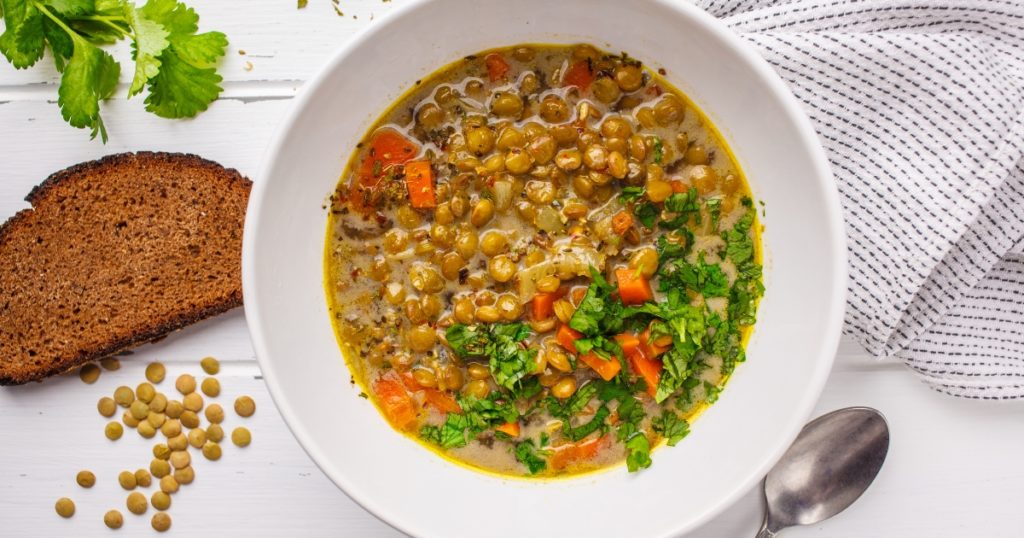
Lentil soup is a hearty and nutritious choice popular in vegetarian diets. Made from lentils, which come in colors like green, brown, and red, this soup is rich in protein and fiber. The soup includes vegetables and spices like onions, carrots, garlic, and cumin, offering a comforting and flavorful meal. It’s perfect on its own or served with a slice of crusty bread.
Cucumber and Tomato Salad

Cucumber and Tomato Salad is a staple in Mediterranean cuisine, known for its simplicity and freshness. It’s mainly made with cucumbers and tomatoes, often tossed with onions, parsley, and sometimes red peppers. For an extra touch, you can add some feta cheese.
Dress up the salad with a drizzle of olive oil, a splash of vinegar, and a squeeze of lemon juice. This light and healthy salad is perfect as a side or as a complement to other dishes.
Baklava
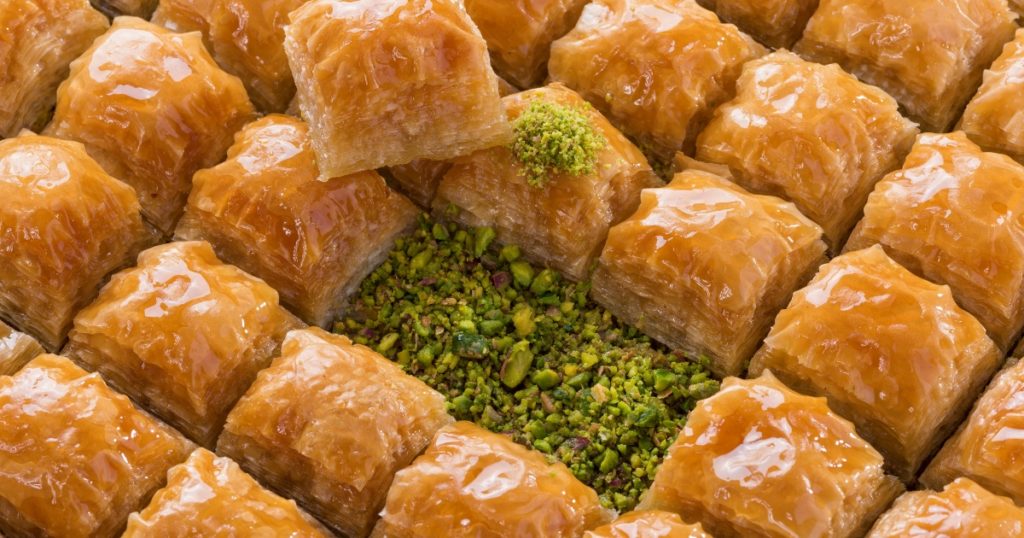
Baklava is a beloved dessert from the Mediterranean and Middle East, made with layers of thin filo pastry, filled with chopped nuts, and sweetened with syrup or honey. It’s popular in countries like Greece, Turkey, and Lebanon. The dessert varies regionally; some versions use walnuts, almonds, or pistachios, and may include spices like cinnamon or flavorings like rose water.
To make baklava, layers of phyllo dough are brushed with butter, filled with nuts, and baked until golden. After baking, a sweet syrup is poured over to soak into the layers. Baklava gets even tastier after a day, making it perfect to pair with black tea. This treat is not only delicious but also steeped in a rich history.
Here’s another fun fact: there’s so much debate about where Baklava came from. Greece and Turkey both claim it came from them, but one thing’s for sure: no one can contest that it’s one of the best desserts the Mediterranean cuisine produced.
Pita Bread
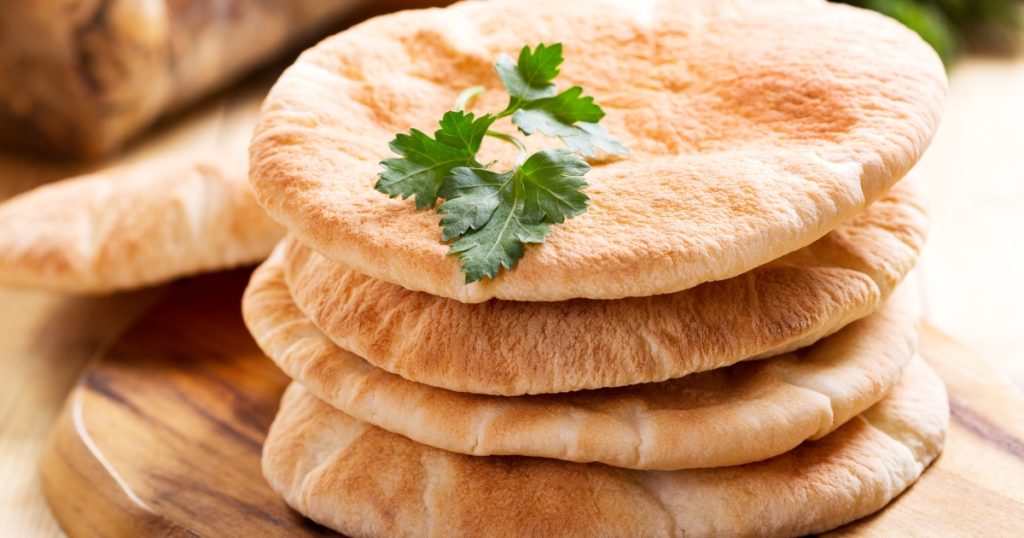
Your Mediterranean food experience will not be complete without Pita bread. This flatbread is made from a simple dough consisting of wheat flour, yeast, water, and salt. After mixing, kneading, and allowing it to rise, the dough is shaped into small balls, rolled out into thin circles, and baked at a high temperature. This process causes the bread to puff up, creating a pocket in the middle.
Pita is perfect for stuffing with fillings like falafel or vegetables and is commonly used for sandwiches and wraps. It also pairs wonderfully with dips such as hummus and baba ganoush. Whether used as a wrap or served plain as a side to various dishes, pita bread completes any Mediterranean meal.
Want to experience our class that involves pita bread? Check out Chef Max Nadin’s Pocket Bread class.
Shakshuka
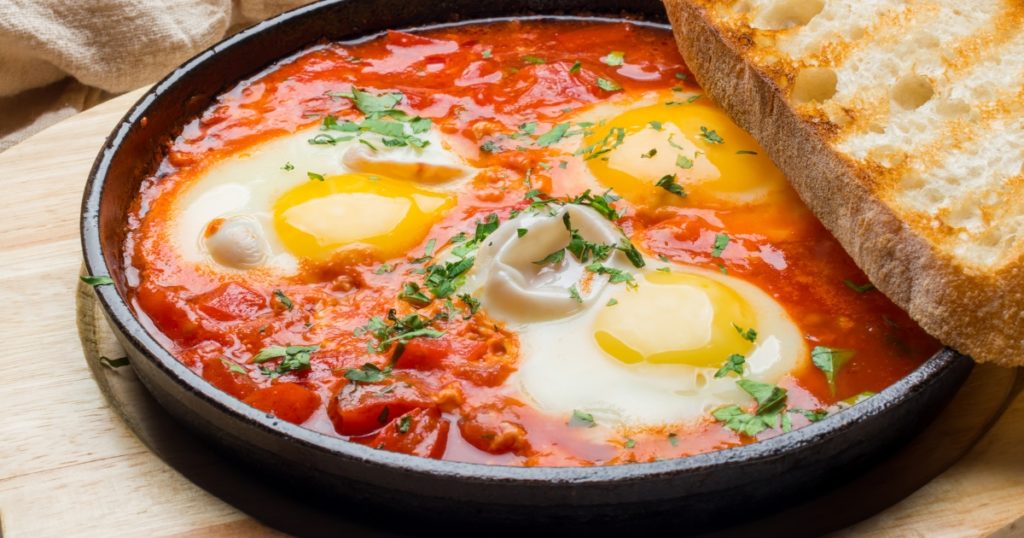
Shakshuka is a vibrant one-pot dish beloved in Mediterranean cuisine, known for its poached eggs simmered in a spicy tomato sauce with onions, bell peppers, and garlic. Originating from Tunisia, where it’s called “a mixture” or “shaken,” this dish packs a punch of flavor with its fresh herbs and a drizzle of extra virgin olive oil.
It’s a versatile meal that can be enjoyed for breakfast, brunch, lunch, or dinner and is often served with bread like pita or challah for dipping into the rich, flavorful sauce. Simple to make yet rich in taste, Shakshuka proves that nutritious and delicious can indeed coexist beautifully in a single dish. Whether you stick with the classic recipe or add your own twist with different spices or vegetables, it’s a satisfying meal that’s sure to impress.
Labneh
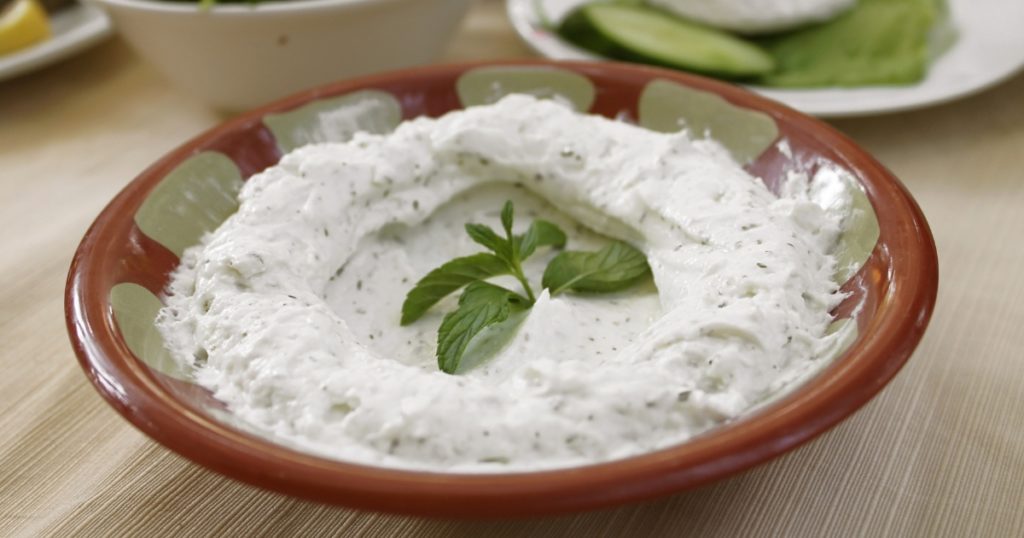
Labneh is a thick and creamy Middle Eastern yogurt dip, made simply by mixing yogurt with a little salt and straining out the whey. Often called labneh cheese due to its thick, spreadable texture, it has a tangy, rich flavor that pairs wonderfully with warm pita bread or pita chips, often drizzled with extra virgin olive oil.
You can also use labneh as a sandwich filler, or as a tasty topping on flatbreads like manaqeesh. It’s a common breakfast or snack item in Middle Eastern cuisine and can be customized with different levels of salt or marinated in oil and herbs for an extra flavor boost. Whether you call it labaneh, labne, or lebnah, it’s a versatile and delicious addition to any meal.
Want to make Mediterranean-style food at home?
Ready to try making Mediterranean-style food at home? It’s easier than you might think! That’s especially since here at The Bailiwick Academy, you can learn Mediterranean-style food recipes with Sir Rodney Martinez latest cooking class: Mediterranean Medley!
Enroll and you’ll no longer be wondering “What is a Mediterranean food menu made of,” because you’ll learn to make the following Mediterranean dishes:
- Baba Ganoush
- Labneh
- Shawarma Pita
- Hummus
- Shawarma Rice
- Falafel with Tzatziki
Just like all the the classes at The Bailiwick Academy, it’s an easy-to-follow class, perfect even if you’re a beginner. You’ll not only learn the basics of Mediterranean cuisine but also gain skills that go beyond the basics—once you’re done, you might be on your way to starting a Mediterranean food business!
So what are you waiting for? Sign up at The Bailiwick Academy and start your journey to mastering the art of Mediterranean cooking, exploring vibrant flavors and healthy recipes right from your own kitchen.
—
Keep coming back to The Bailiwick Academy blog for more cooking and baking tips, kitchen tricks, and much more!
]]>I hope you get inspired by them!
Why Catering Is A Big Opportunity in 2024
2024 is shaping up to be a great year for starting a catering business. What makes me say this, you ask?
- There are already projections of more business meetings and corporate events this year. And if you remember one of my tips for standing out as a catering business, it’s to close plenty of corporate clients. 2024 makes it super possible to succeed in catering.
- There are always weddings here in the Philippines. For example, according to the Philippine Statistics Authority (PSA), the number of people who got married increased from 2019 to 2022. I’m pretty sure the same thing happened in 2023, and will happen in 2024!
- And of course, Filipinos love to party and celebrate special occasions such as baptisms or birthdays. And with celebrations always come food, which means more catering opportunities success—and income!
Those three are more than enough reasons, wouldn’t you agree?
How To Really Succeed In Catering
Are you now really, REALLY encouraged to try your hand at catering this 2024? I hope so, especially if you’ve been dreaming of coming up with a cooking and baking empire for a long time already!
Now, how exactly do you go about it? Sure, I gave you seven tips to get started on a catering business… but I feel like the best way to really find out is to check out some of the best caterers in the Philippines!
I did a quick search, found this list, and this list, and found some commonalities of what makes them great, according to the lists:
- Delicious food of different cuisines
- Great service
- Beautiful setups
- An overall amazing experience
But here’s the thing: knowing what makes a great caterer and actually implementing these things are two different sides of the coin.
Besides, even if you know, how can you be sure that you can apply the knowledge and actually achieve catering greatness?
Well, that’s where Catering 101 of The Bailiwick Academy comes in!
Succeed in Catering in 2024 With Catering 101
Our Catering 101 course is like a training camp for caterers, perfect for enthusiastic home cooks like you.
You’ll pick up skills to make your catering business really stand out. This includes learning effective marketing, creating a memorable menu, and setting the right prices to ensure good profits.
We’ll show you how to smoothly handle tough situations and demanding customers. Plus, you’ll learn ways to make such a great impression that your customers will be eager to return.
This course is filled with tips and tricks from some of the Philippines’ top caterers and chefs.
By the end of it, you’ll be ready to handle big events, lead a great team, and have the know-how to expand your catering business.
Who will be teaching Catering 101?
We were on the lookout for caterers who could help us make this class really comprehensive… and we’re lucky that we already have onboard Chef Him Uy De Baron!
Chef Him is hailed as one of the biggest names in the culinary world, Chef Him runs various restaurants all over the Philippines and is one of the instructors inside The Bailiwick Academy since 2022.
Check out the preview of this class here:
But it’s not just Chef Him. Meet the others:
- Beejay Tantoco, who runs his family catering business Tantoco’s Catering (established in 1994) where they close government accounts, serve celebrities, and entered popular food markets like Mercato and Bancheto.
- Chef Kalel Chan, a corporate chef of Raintree Restaurants which operates 10 restaurants — Farmer’s table, Saboten, Cha Cha’s Boracay, The Coconut Club, Izakaya Sensu, My Country House, Jones All Day, and so much more. He’s famous for The Original Ube Champorado!
- Aileen Ferrer, a Bailiwicker, our community manager of the TBA Student Lounge, and a businesswoman who runs “Unwrapped – Flowers, Hampers and Events” — a flourishing floral and event styling company that works with corporate clients, weddings, and various events.
- Michelle Lazaro, another Bailiwicker who runs Balai Calamba, a catering business based in Laguna. She also owns two commercial kitchens strategically located in Las Piñas and Laguna. She has catered for corporate events of Hyundai, Chery, and Foton.
- We also have a mystery chef! He has been in the food business for almost 20 years. His experience includes working for Nestle as a Regional Chef Consultant, running a Catering Business since 2004, and starting a new food business last 2022. You’ll find out who he is when you join the program!
How Catering 101 Will Go
Catering 101 starts on January 28, 2024, and will be broken up into six strategic modules to help you succeed in catering.
Week 1: Laying the Foundations For a Successful Catering Success
This week, you’ll dive into the essentials of starting a catering business. This includes understanding the market, the diverse roles in catering, and what initial capital you’ll need. You’ll also learn about building a strong team, crucial for a successful operation.
- Discover the catering market opportunities, especially in the Philippine context.
- Learn directly from industry experts about starting a catering business, covering everything from capital needs to logistics.
- Understand the various roles you’ll play, from chef to business strategist.
- Get a detailed breakdown of initial capital requirements for budget planning.
- Learn how to assemble a strong team, including roles like event managers and chefs.
- Gain real-world insights from successful caterers on launching and growing your business in the Philippines.
- Balance your passion for food with the skills needed for running a successful business.
Week #2: Crafting a Unique Brand that Makes Sales and Marketing Simple
Week 2 focuses on branding, sales, and marketing in the catering industry. You’ll learn how to differentiate your business in a competitive market and make an impact.
- Understand the different catering types and their unique needs.
- Learn how to evaluate your competition and identify your unique selling points.
- Gain insights from real-life examples on effective brand positioning.
- Learn how to engage potential clients with compelling sales pitches.
- Create a targeted marketing plan and schedule.
- Learn the steps for testing your business concept before a full-scale launch.
- Understand the importance of maintaining good relationships in corporate catering.
Week #3: Create Irresistible Menus and Aesthetically-Pleasing Meals Like a Catering Pro
In Week 3, you’ll delve into menu planning and food presentation, learning how to create menus that are both delicious and practical for catering.
- Explore various menu styles and learn how to select the best for different events.
- Learn recipe selection that’s both tasty and catering-friendly.
- Understand the challenges of catering food, including logistics and quality maintenance.
- Acquire skills in food presentation to enhance event dining experiences.
- Learn essential food safety practices.
- Manage supplies effectively and build strong supplier relationships.
- Get advice on setting up an efficient off-site kitchen.
Week #4: Costing and Pricing Best Practices to Maximize Profits
This week is all about the financial side of catering, focusing on recipe costing, pricing strategies, and understanding overhead costs.
- Learn to cost recipes accurately and understand their financial impact.
- Develop effective pricing strategies that reflect your service’s value.
- Understand the overhead costs involved in catering.
- Design profitable and appealing menus.
- Develop financial management skills for long-term success.
- Balance cost-effectiveness with high-quality offerings.
- Adapt pricing strategies to market dynamics and customer expectations.
Week #5: Master the Essentials of Booking, Service, and Crisis Management
The fifth week covers the practical aspects of managing catering events, from booking to service standards and crisis management.
- Learn the comprehensive process of booking events.
- Master creating a BEO for outlining event details.
- Develop a culture of excellent service in your team.
- Handle crises and difficult clients professionally.
- Follow up with clients post-event for feedback and repeat business.
- Use successful events as marketing tools while respecting client privacy.
Week #6: The Essentials of Table Styling for Every Occasion
In the final week, you’ll learn the art of table styling, ensuring your setups are as memorable as your food.
- Learn to set up buffet and dining tables for various events.
- Choose the right serving and dinnerware to enhance the dining experience.
- Discover flower arrangement tips for stunning table displays.
- Customize table setups for different themes.
- Receive step-by-step instructions for flawless table presentations.
By the end of these six weeks, you’ll have a comprehensive understanding of starting and running a successful catering business, equipped with practical skills and insider knowledge!
How To Enroll In Catering 101
It’s easy! All you have to do is sign up at The Bailiwick Academy then go over to the Catering 101 Page. Enroll, and then make sure to block off January 28, 2024, as that’s the first day of class!
Final Thoughts About How To Succeed in Catering in 2024
Looking ahead to 2024, it’s clear that there’s a big chance for success in the catering business. With more companies holding events, lots of weddings, and Filipinos loving big celebrations, there’s plenty of work for caterers.
To really do well in catering, you need to mix your love for cooking with smart business skills. That’s where our Catering 101 course at The Bailiwick Academy comes in. It teaches you everything from understanding what customers want to making your catering stand out, to handling money matters.
You’ll learn from experts like Chef Him Uy De Baron, who know all about making great food and running a successful business. They’ll share their secrets on how to make your catering unforgettable and how to handle any tough situations that come up.
Don’t miss this opportunity to turn your passion into a profitable venture! Become one of the Bailiwickers trained by successful food business owners on how to launch a catering business in 2024.
Join Catering 101 today. See you inside!
—
Keep coming back to The Bailiwick Academy blog for more baking and cooking tips, kitchen tricks, and much more!
]]>Well, read on to ensure that as much as possible, it’s your name—and your menu—on everyone’s lips!
Catering Tips 1 of 5: Close Corporate Catering Clients—And Stay Friends With Them!
Out of the many catering tips for your next corporate event, here’s one to keep in mind. Why? Well:
- Corporate clients often host multiple events throughout the year, providing a steady stream of opportunities. Research corporate events and you’ll find plenty of variations: team buildings, awarding ceremonies, recognitions, Christmas parties, and so on. Imagine being able to cater for all those!
- Satisfied corporate clients are likely to recommend your services to other businesses and colleagues.
- Corporate events often have larger budgets, allowing for more creative and expansive catering options. Of course, they may have higher expectations as well, but I’m sure you’re more than able to meet that challenge!
- Catering for corporate events can increase your brand’s visibility among a wider, professional audience. That’s especially true since these events are great for networking, potentially leading to more business and partnerships. Of course, this means you need a team to do everything for you while you network and shake hands—don’t forget this part!
At the end of the day, you need leads and returning clients to survive—money, after all, is the lifeblood of all businesses. Corporate clients help you achieve that. By nurturing strong relationships with them, you’re doing more than just catering – you’re creating a supportive network for your business.
Catering Tips 2 of 5: Specialize In A Catering Style
If you read Chef Joey Prats’ spotlight in this blog, you’d know that one of the things he advocates for is focusing on one product. That way, you can go all in on creating the product and becoming known for it.
Well, guess what? You can apply the same concept to your catering. Specializing in a particular style or type of cuisine can set you apart from competitors.
Whether it’s gourmet, vegan, local cuisine, or themed events, having a niche makes your service unique and memorable. By specializing in a certain type of food or style, like gourmet, vegan, or local dishes, you become the go-to person for that special kind of catering. It’s a great way to draw in customers who want exactly what you offer and to build a name for yourself as the expert in your chosen area.
Catering Tips 3 of 5: Develop “Travel-Friendly” Food Selections And Solutions
One challenge when it comes to preparing food ahead of time is transportation. No one wants their beautifully prepared dishes to turn into a messy, unappetizing heap during the journey, agree? That’s why developing a menu with “travel-friendly” food selections is so important.
Here’s how to ensure your dishes remain appealing and delicious, even on the go:
- Opt for foods that can withstand travel to the event space without losing their appeal. Baked goods, casseroles, and sturdy salads are great choices.
- Select items that stay fresh at room temperature or can be easily reheated without compromising quality.
- Food safety is important! Use containers that protect the food, maintain food temperature (both hot and cold), and prevent cross-contamination and spills or messes during transport.
- Conduct trial runs to see how dishes fare during transport to the event space, adjusting recipes or packaging as needed.
- Ensure that the food still looks appetizing upon arrival, considering factors like sauce separation or garnish displacement.
- Design dishes that are easy to plate quickly and attractively at the event location, minimizing on-site prep work.
Remember, in catering, how your food travels is just as important as how it tastes! Considering these factors ensures that your food is always served at its best, leaving a lasting impression on your clients and their guests.
Catering Tips 4 of 5: Create Crisis Management Protocols
According to cvent, there are different types of caterers: front-facing caterers who help with setup and guest relations; catering chefs who stay in the kitchen; and catering managers who oversee the entire catering team of servers and cooks.
However, as the business owner, whether you prefer front-facing catering or staying in the kitchen as the catering chef, you’ll have to be prepared for any crisis that may arise. And yes, in the catering business, unexpected situations are bound to arise!
Here’s how you can create effective crisis management protocols to save the day:
- Understand the types of emergencies that could occur, such as food shortages, equipment malfunctions, or staffing issues.
- For each potential crisis, have a clear plan of action. This might include backup suppliers, extra equipment, or a pool of on-call staff.
- Ensure every team member knows their role in a crisis. Regular training sessions can help keep everyone prepared and confident.
- Establish clear lines of communication for quick and effective coordination during a crisis.
- Of course, don’t forget that as your business grows and changes, so should your crisis management plans. Regularly review and update them to ensure they remain effective.
By having solid crisis management protocols in place and being prepared for the unexpected, you show professionalism and can significantly enhance your reputation in the industry.
Catering Tips 5 of 5: Catering A+++ After Service
Out of all the catering tips here, this might be the most important.
You know what pro caterers do when they’re done with the event? They don’t just pack up and leave! They make sure that they have excellent after-service.
Here’s why and how to excel in after-service:
- Reach out to your clients to ask for their feedback. This shows that you care about their experience and are always looking to improve. Constructive feedback is invaluable for refining your service and menu.
- A simple thank you note or call to your clients can go a long way. It demonstrates your appreciation for their business and helps in building a lasting relationship.
- Use the follow-up as an opportunity to discuss future events. Inquire about any upcoming events they might be planning and how you can be a part of them. This proactive approach can secure future bookings.
- If your clients are happy with your service, ask them to refer you to others. Word-of-mouth is a powerful tool in the catering industry, and satisfied clients are often your best advocates. Try getting them on video talking about their experience with your company.
- Keep your clients in the loop about your new services, menus, or special offers. Regular, non-intrusive communication keeps you at the forefront of their minds for future catering needs.
- If a client has any complaints, address them promptly and professionally. How you handle issues can sometimes leave a more lasting impression than the service itself. Be as nice and graceful as possible, and remember that most people aren’t trying to be difficult; they just want someone to listen to them and give them a solution to their problem.
Final Thoughts
In wrapping up, these five catering tips are your roadmap to not just surviving but thriving in the competitive world of catering. By implementing these tips, you’re setting yourself up for success and longevity in the catering business. Remember, it’s not just about serving great food; it’s about creating an entire experience that resonates with your clients.
Ready to start your catering business but you don’t know where to start? Watch for my next blog post. I’ll be featuring some successful caterers, what they did, and how you can copy some of their methods to start a catering business of your own this 2024!
And before I go, I’d just like to remind you: don’t forget to sign up at The Bailiwick Academy for recipes you can use in any catering event!
—
Keep coming back to The Bailiwick Academy blog for more baking and cooking tips, kitchen tricks, and much more!
]]>Well, I’m not going to lie to you; it can be very scary to think about, but it’s also totally possible! And in this blog, we’re going to explore the idea of starting a catering business from home.
Let’s dive in and find out how you can make this home-based catering business happen!
Who is a home-based catering business for?
If you have a passion for cooking and enjoy making others feel welcome, then starting a catering business from your home might be the perfect fit for you. This business model is especially great for stay-at-home parents who are looking to balance family life with a fulfilling career, aspiring chefs eager to showcase their culinary talents, or anyone wanting to move away from the regular 9-to-5 routine in favor of something more personally rewarding.
Keep in mind, though, that it takes a good dose of discipline, strong organizational skills, and a touch of creativity to truly stand out in the busy catering market. But if you’re up for the challenge, this could be an exciting and fulfilling path for you!
Catering Business From Home: More Than Just Being A Good Cook
Starting a catering business takes a lot more than just being good at making tasty food. Here’s a look at some things you need to consider when starting out to make your home-based catering business a success.
Know Who You Want To Serve
First things first, you need to figure out who wants to eat your food. Do you want to cook for birthday parties, weddings, and other special occasions, or small get-togethers and celebrations that call for food? Knowing your wanted target market helps you decide what kind of food to make and how to advertise your business.
Learn The Business Side
When you decide to run a home business, you won’t just be a home cook. You’ll have to think of yourself now as an actual business owner, like a restaurant owner or a food truck owner. You’ll now have to think about your menu, your menu pricing, how to keep track of your money, and different marketing strategies to let people know about your business.
Stay Safe And Legal
With this business model, making sure your food is safe to eat is super important. You’ll need to know and follow the rules about food safety and maybe get your kitchen checked out by the health department and get the necessary health permit. This keeps you and your customers safe.
Oh and of course, you’ll have to get a business license to keep things legal.
The Work Catering Business At Home Entails
Now that we’ve gotten some of the planning out of the way, the next step is looking at some aspects of the day-to-day work it entails. In no particular order, here are some to keep in mind.
Menu Planning, Food Preparation, and Presentation
A significant part of your day will be spent on menu planning. This can get complicated because you’ll have to create a cohesive menu that appeals to your clients, fits their event theme, and works within their budget. And once the menu is set, there’s the food preparation, which involves sourcing fresh ingredients, prepping them, and ensuring each dish is cooked to perfection.
Let’s not forget presentation—the way the food looks on the plate is just as important as how it tastes. This requires a creative eye and attention to detail.
Customer Service and Marketing
Customer service is key in the catering world. You’ll be communicating with clients, understanding their needs, and ensuring their satisfaction. This could mean answering emails, taking calls, and sometimes dealing with last-minute changes or special requests.
Marketing is another crucial aspect. You will have to manage your business’s social media profiles, update your website, and create content like blogs or videos to engage potential clients.
Networking, both online and in person, is also part of marketing. Building relationships with Getting to know people who can help your business is a big deal. This could be event planners, other businesses that can help you, or customers who can do word-of-mouth marketing for you to make other people patronize your services and give you more opportunities.
Administrative Tasks
Administrative tasks include everything from managing bookings and invoices to keeping track of expenses and ensuring you’re compliant with any local business regulations. Good organizational skills are essential here to keep everything running smoothly.
Physical and Mental Demands
It’s important to acknowledge that catering can be physically demanding. You’ll be on your feet for extended periods, sometimes lifting heavy pots or standing over a hot stove for hours. It’s not just a physical challenge but a mental one as well. Each event comes with its own set of intricacies – from special dietary needs to ensuring the timing of each course is spot on.
Planning Your Time
Catering can get busy, especially when you have a lot of orders. You need to be good at planning. This means knowing when to shop for ingredients and to restock your pantry, when to start cooking, and how to get everything ready without rushing at the last minute.
Being Ready for Anything
Sometimes, things don’t go as planned. Maybe you need to change a menu quickly, some of your food handlers called in sick, an event planner is not being cooperative, or you’ll need to handle a difficult client at an event. Being able to think on your feet and solve problems fast is a big part of catering.
Work Hard AND Smart
Based on the above, we can conclude that like any home-based businesses, a catering business out of your home will take a LOT of work. But that doesn’t mean you have to do it all—that won’t be an efficient use of your time. Let’s see some ways you can make home catering easier for you.
Make Friends with Efficiency
Think of your kitchen as your command center. Organize it so everything you need is right at your fingertips. Plan your menus to make the most of your ingredients and time to make everything flow smoothly.
Embrace Technology
Think of technology as a helpful friend who’s always there when you need them. Use apps for keeping track of ingredients, social media to show off your delicious dishes, and online tools for all the behind-the-scenes business stuff.
Love Numbers
You may not really like math, but keeping an eye on your finances can actually be fun (really!). Think of it as the scorecard of your business – it tells you how well you’re playing the game. Grow to love numbers, and you’ll be able to set prices that make sense as well as know where your money’s really going.
Ask For Help When You Need It
Remember, even superheroes have sidekicks. As your business grows, it’s okay to delegate and get help. Maybe it’s someone to serve as an extra pair of hands in the kitchen or someone to do social media for you. It frees you up to focus on what you do best: making amazing food.
Factors To Consider For Running A Food Business Out Of Your Home Successfully
Once you’ve got your home catering business going, the next step is to keep it successful for years to come. Here are some easy-to-follow tips to help you do just that:
Update Your Home Catering Business Plan Regularly
Think of your business plan like a garden – it needs regular care to grow. As things change in your business and the world around you, update your plans. This might mean trying new types of events or changing how you manage your money.
Keep Your Customers Happy
Happy customers are the key to a successful business. Always try to make their experience with you something special. Pay attention to the little things, listen to their needs, and try to give them more than they expect. They’ll likely tell their friends about you, which can bring in more business.
Keep Up with Trends
Stay in the loop with what’s new in catering and food. This could be new food trends, ways of serving, or even tech tools that make your job easier. Being one step ahead can make your business stand out.
Learn and Grow
Keep learning new things about cooking and running a business. You might take a class, go to a workshop, or join a group of other caterers. Growing your skills keeps your business fresh and exciting.
Build a Great Team
If your business gets busy, you might need to hire some help. Take the time to train them well so they understand how you like things done. A good team can help you take on bigger jobs and do even more.
Check Your Prices
Every now and then, take a look at your prices. Make sure they’re fair for your customers but also that you’re making enough money. As things change, like the cost of food, you might need to adjust your prices.
Be Smart with Money
Keep a close eye on your money. Make sure you’re not spending too much and save some for slower times. Being careful with money helps your business stay strong.
By following these simple steps, you can keep your home catering business going strong for a long time.
Final Thoughts About Having A Catering Business Out Of Your Home
So, can you run a catering business from home? The short answer is yes! You just have to be ready to do the work and keep at it.
Now, you might be thinking, “This sounds like a lot of work, and maybe it’s a bit too much to handle.” Don’t worry, I’ve got your back!
In our next blog post, we’re going to cover “The 7 Crucial Steps to Starting a Thriving Catering Business in 2024.” These are going to be super helpful. Just focus on them, and you’ll greatly increase your chances of making your business a hit!
Stay tuned! And in the meantime, sign up at The Bailiwick Academy and start browsing our courses for ideas on what you can add to your future catering menu!
—
Keep coming back to The Bailiwick Academy blog for more baking and cooking tips, kitchen tricks, and much more!
Keep reading for reasons I’m sure you will be able to relate to, especially if you’re a fellow mom.
A Brief History of Fried Chicken
Before we answer why do I like fried chicken so much, let’s take a quick look at where fried chicken came from. According to The Cookful, this beloved dish has two origin stories. One is that it came from the Scottish who decided to start deep frying chicken while the rest of the world was still just baking or broiling it—and that’s how it came to America eventually via Scottish immigrants.
The other story is that it came from West Africa, since the people there already have a tradition of frying food in hot oil. It was because of slavery that fried food made its way to America. Despite this particular origin being tied to a shameful period of American history, fried chicken has evolved into a widely enjoyed dish, and its popularity continues to endure.
Whatever the real story, fried chicken came to America, and continued to grow in popularity until it pretty much conquered the world! Think about it: can you name any common restaurant or convenience store that doesn’t have fried chicken in its menu?
I didn’t think so!
Reasons Why I Love Fried Chicken
Now, going back, why do I love chicken so much? Well, I’ve thought about it pretty well, and ultimately, it boils down to seven reasons.
Reason 1: It’s Super Easy To Make
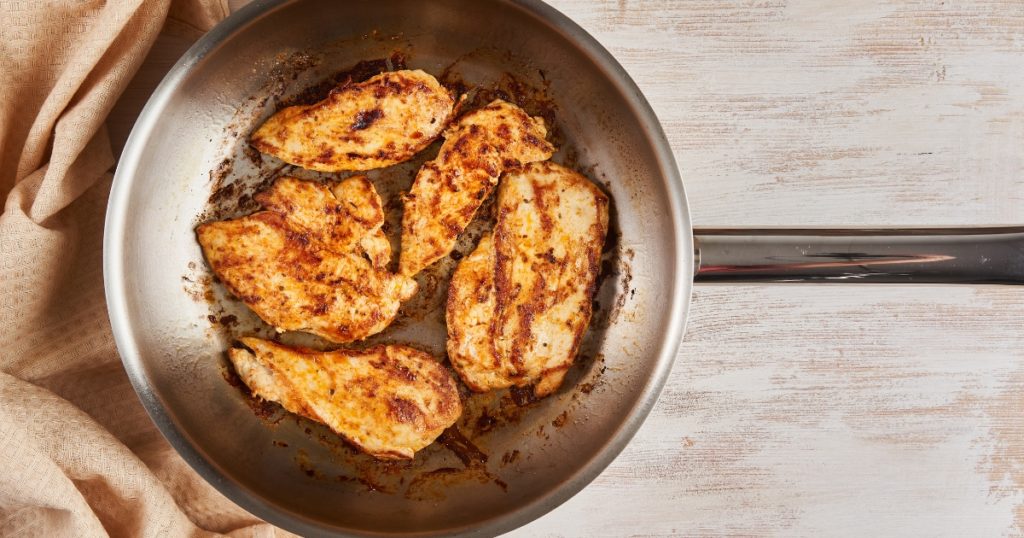
Fried chicken is the ultimate go-to for us busy moms. In fact, because it’s pretty fast and convenient to make, it’s a lifesaver!
Think about it; you can:
- Marinate chicken pieces with simple pantry staples like soy sauce, calamansi, and a bit of garlic, then use a pan or airfryer to achieve crispiness in an hour or less; or
- Get some already breaded chicken from the grocery, pop it in the oven toaster, wait, and eat fried chicken!
In short, fried chicken is always there to save the day, especially on those lunches or dinners when you can’t really think of what to cook.
Reason 2: Fried Chicken Is Easy To Access
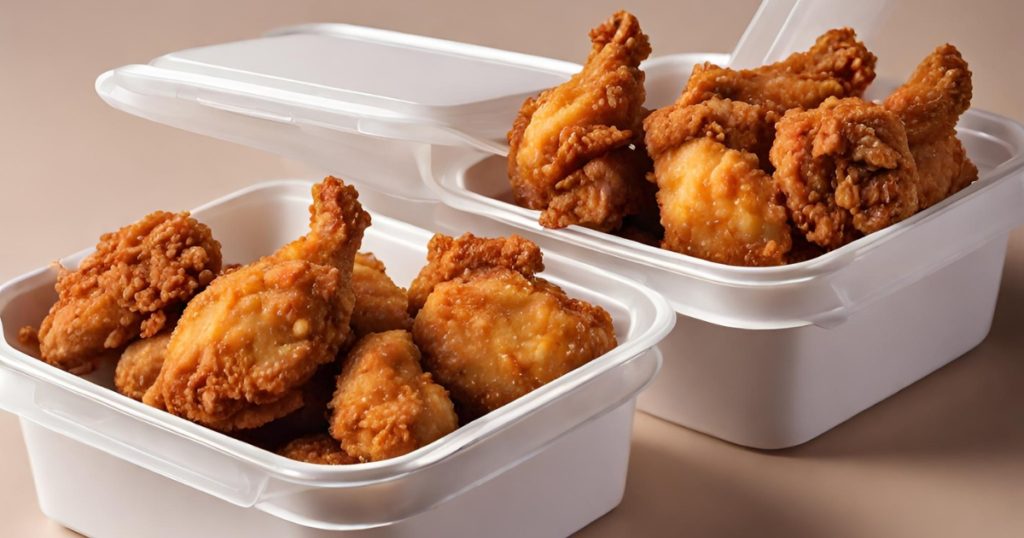
Fried chicken is practically everywhere here in the Philippines. Even street vendors have their own version. There’s just something about the taste of this deep fried goodness, I guess.
And that’s the great thing: it’s so common, you can get it anytime, anywhere, whether you’re at home and not wanting to cook, or on the road, and you’re looking for some delicious food. Admit it: you already have favorite fried chicken spots, such as one that has a secret mix of herbs and spices which makes it finger lickin’ good!
Reason 3: Practically Everyone Loves Fried Chicken

Who can resist fried chicken? No one, that’s for sure! Even the pickiest of eaters can’t resist this particular fried food. It’s the one dish that will bring smiles to everyone at the table.
Reason 4: Science Backs Me Up!

Did you know that even science explains why fried chicken tastes are irresistible? It’s all about the chemistry of fried food, also known as the Maillard reaction. It gives fried chicken the tempting golden color and mouth-watering flavor. This reaction creates a variety of flavor compounds, making each bite a complex taste experience.
But there’s more: the texture! The contrast between the crunchy outside and the juicy inside is scientifically proven to delight our taste buds. Studies show that this texture contrast not only pleases our palate but also makes us crave more. So, when we’re enjoying that crispy, juicy chicken, we’re actually delighting in a culinary marvel of science—cool, huh?
Reason 5: Fried Chicken Is Comfort Food

There’s an undeniable comfort in a good piece of fried chicken—there’s warmth and satisfaction that comes with every bite. The symbolism of fried chicken is a taste of home, no matter where you are.
And if you think about it, fried chicken is so delicious, but there’s more! Each crunchy bite reminds us of festive family celebrations, lazy Sunday lunches, and those impromptu gatherings that turn into cherished memories. It’s more than just food; it’s a comforting embrace, a reminder of happy times, and a simple pleasure that connects us to our loved ones and our roots.
Reason 6: It Goes With Everything
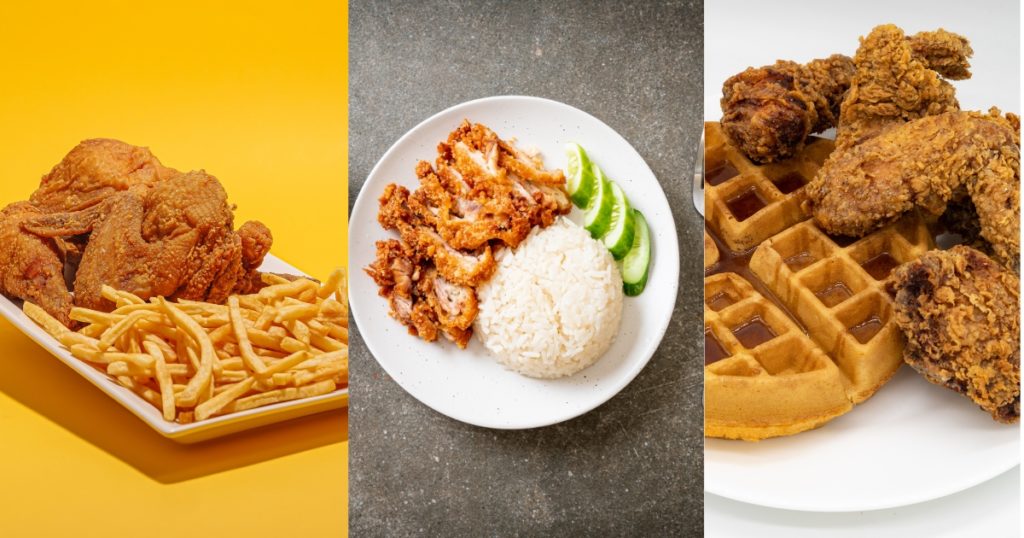
One of the best things about fried chicken is its incredible versatility. Whether it’s paired with rice, crispy fries, waffles, or if you want to use it as the meat for your sandwich, chicken just simply goes with everything!
Fried chicken also even fits into all kinds of meal settings. It’s a hit at a fancy dinner party, just as much as it is during a summer barbecue. No matter the occasion or the time of day, fried chicken is always welcome to the table.
Reason 7: Fried Chicken Is Very Versatile
Why do I love fried chicken? One more reason is it’s because it’s very versatile! You can enjoy the classic chicken taste, or go spicy, sweet, sour, and more. It’s always fun to play around and create your version of this beloved dish.
Let’s not forget the endless possibilities of flavors and marinades. You can go from a simple garlic and soy sauce marinade to a more adventurous coconut milk and lemongrass blend. The possibilities are endless!
Final Thoughts
So there you have it, my fellow Filipino moms! Fried chicken is more than just a dish; it’s a part of our culture, a comforting presence in our lives, and a reason to come together and celebrate. Here’s to more crispy, juicy, delightful moments – one piece at a time!
Love fried chicken? You’ll love this class!
As passionate about fried chicken as I am? Want to experience delicious fried chicken with those commercial tastes you love? Want to take your food business to the next level?
Well, you can do all that with the latest class here at The Bailiwick Academy by Chef Anthony Ang: Fry ‘Em Up: Pinoy Style-Fried Chicken!
This isn’t just any cooking class. It’s a golden opportunity to recreate the iconic flavors of famous Filipino fast-food fried chicken. Imagine mastering the art of making Whole Fried Chicken, Classic Chinese-style fried Chicken, and the crowd-pleaser, Famous Fast Food Fried Chicken—all of them tasting like some of those commercial chickens you love, or even better!
There’s a bonus too! You’ll learn the secret behind making super delicious garlic fried rice that pairs perfectly with these crispy delights.
Whether you’re a home cook looking to wow your family or an aspiring entrepreneur ready to cater to your clients’ discerning tastes, this class might be the one you’re looking for. Don’t miss out on this finger-licking opportunity—sign up at The Bailiwick Academy today and enroll in this class to elevate your fried chicken game!
—
Keep coming back to The Bailiwick Academy blog for more baking and cooking tips, kitchen tricks, and much more!
]]>Well, reading this blog is your chance to satisfy that curiosity. Keep on reading to know more about dim sum, like its origins, and discovering the variety it offers beyond our beloved siopao and siomai.
Ready to embark on this tasty journey? Let’s begin!
So what is dim sum, exactly?
Dimsum or dim sum, a term that resonates with “a touch to the heart,” is a traditional Chinese cuisine (mainly Cantonese cuisine, although other Chinese cuisines have their own form of dimsum) that consists of a variety of small, savory and/or sweet dishes, ranging from dumplings to buns, and rolls to cakes. Think of it as being similar to Spanish tapas or Filipino salu-salo—the dishes are shared among family and friends. Traditional dim sum is a brunch meal, usually enjoyed with tea (yum cha).
Thankfully, a modern dim sum meal doesn’t necessarily need you to drink tea (good news for those non-tea lovers out there). Eating dim sum doesn’t also have to be restricted to brunch; you can have dimsum for lunch, dinner, or even merienda.
What are the origins of dimsum?
Like with many delicious treats (i.e. the opera cake), the origins of the dim sum dish have plenty of versions, such as:
- The first written reference to the “dim sum” was during the Tang dynasty, where it was used to mean “barely fill the stomach.” However, dim sum was common all the way back in the Song dynasty (960–1279) in China—royal chefs were tasked with creating new varieties of small dishes.
- Some believe that dim sum originated in tea houses along the Silk Road as long ago as 2,500 years ago as a light accompaniment to special appetite-stimulating teas given to travelers
- One more story is that the Cantonese dim sum culture started in tearooms in the latter half of the 19th century in Guangzhou, the capital of Guangdong. Silk Road travelers and traders would take breaks in tea houses and eat dim sum. The practice eventually spread and became popular, especially in Hong Kong.
Whatever the true origins of dimsum, we’re glad it exists, and that there are plenty of dim sum restaurants to get our fix, agree?
What are typical dim sum dishes?
When you order dimsum from a dim sum restaurant, you’ll get a variety of small food plates and/or bamboo steamers. You can get steamed dishes or fried or baked ones. Here are some popular dim sum dishes.
Savory Dim Sum
Gao
These are dumplings wrapped in thin skin, filled with ingredients such as meat, vegetables, and/or seafood.
Siu Mai
Siu mai or siomai for us Pinoys are dumplings with a pork and cabbage filling, often served in steamed or fried versions. We’ve also made variations like beef and chicken siomai.
Har Gow
These translucent, pleated shrimp dumplings are a test of a chef’s skill – delicate and flavorful.
Char Siu Bao
Barbecued pork buns in English. These are steamed buns filled with a mixture of pork, vegetables, and other ingredients, often topped with a BBQ sauce. Think of them like our asado rolls.
Cheong Fun
Rice noodle rolls that are steamed and have various fillings. They’re akin to lumpiang sariwa, but with a softer, silkier texture.
Sweet Dim Sum
Custard Buns
These are steamed buns with a creamy, sweet custard filling. The filling is usually a rich, eggy custard, offering a delightful contrast to the soft bun. They’re a favorite for their indulgent and comforting taste.
Egg Tarts
Also known as egg custard, these are sweet tarts with a flaky pastry crust and a creamy, custard-like filling. They are a staple in many dim sum restaurants. People love them for their rich, sweet flavor.
Mango Pudding
A refreshing and fruity dessert, mango pudding is smooth and creamy, often served chilled with a topping of fresh mango pieces or a light cream.
Sesame Seed Balls
Known locally as buchi, these chewy, deep-fried sesame balls are coated with sesame seeds and usually filled with sweet red bean paste. They have a crispy exterior and a soft, sweet interior.
Almond Jelly
Often served with fruit, this jelly is mild in flavor and made with almond milk or extract. It’s a subtle dessert for those who prefer less sweetness.
Do note that dim sum is not limited to these dishes, as there are over one thousand varieties of dim sum. Check out Dimsum 101 and Dimsum 102 here at The Bailiwick Academy for more specific examples.
What’s the best way to enjoy dimsum?
Want to fully savor dimsum? Here are some tips to keep in mind!
- Enjoy the flavors slowly, especially with complex dishes like xiao long bao (soup dumplings). Let the soup inside cool a bit before taking a bite.
- High-quality dim sum is usually well-seasoned. Therefore, additional sauce might not be necessary, even if we Pinoys can’t help putting soy sauce. If needed, add a small amount of soy sauce or chili and adjust to taste.
- Use chopsticks to hold the dim sum and take smaller bites, allowing the food to cool down. Some items, like shrimp dumplings, you can finish in a single bite.
- The communal nature of sharing various dishes makes dim sum a social and enjoyable experience, best enjoyed with family or friends. Of course, there’s no one to stop you if you want to enjoy dimsum by yourself!
- Embrace the variety of dim sum. Mix steamed, fried, and baked items, including classics and more adventurous choices.
- For fun, eat dim sum the traditional Chinese way: with tea! Plus, it does aid your digestion.
- Begin with lighter, steamed dishes before moving to heavier, fried items to appreciate the subtle flavors.
- Mind dim sum etiquette. Use communal chopsticks or serving spoons for sharing, pour tea for others first, and tap the table to thank someone who pours tea for you.
Enjoy dim sum the Filipino way!
For us Pinoys, we love to eat almost everything with rice, even our sweets like kakanin! And guess what? You can easily enjoy dim sum with rice too—even without going to any dimsum place.
Thanks to Chef Allan Mertola’s new class, Dimsum Rice Toppings, it’s now simple to bring these tasty dim sum flavors to our everyday rice meals at home.
In this class, you can make nine different kinds of rice toppings:
- Chicken Mushroom
- Pork and Shrimp
- Pork Ribs with Tausi
- Spicy Asado Squid
- Shanghainese Dumpling
- Pork Scallop
- Chinese Kikiam
- Beef Ball
- Crispy Prawn Dumpling
And even get a bonus recipe for Yang Chow Fried Rice to make your dimsum with rice experience really special! If your family loves dim sum food, this class will surely make you a superstar in their eyes!
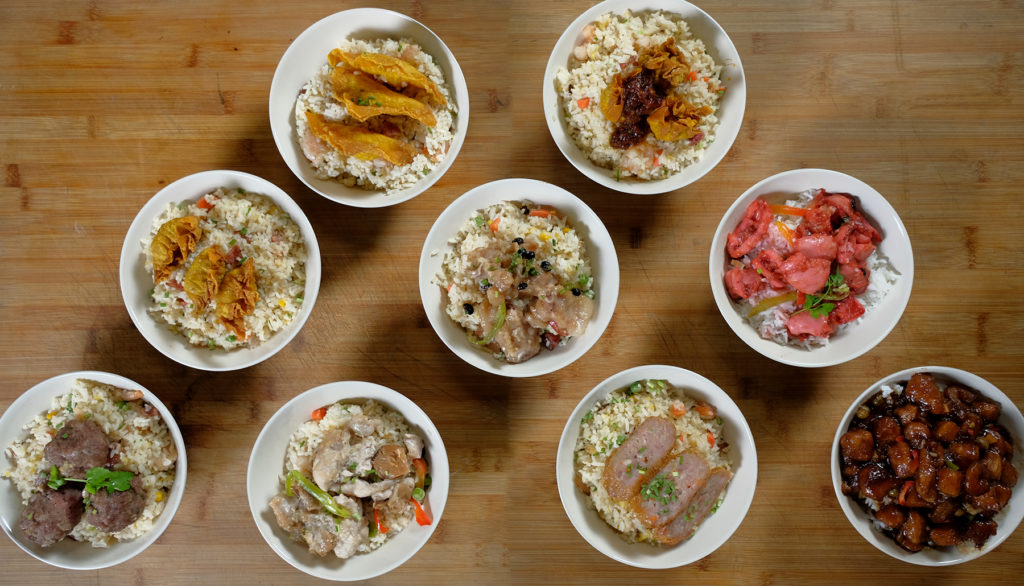
It’s great for business as well. As we said above, Pinoys LOVE Chinese food!
Ready to add some sizzle to your everyday meals or food business? Sign up at The Bailiwick Academy, enroll in this class, and watch the magic happen!
—
Keep coming back to The Bailiwick Academy blog for more baking and cooking tips, kitchen tricks, and much more!
]]>We will answer that—and give you seven you should give a try if ever you find yourself wandering into a tapas bar. Let’s get to it, shall we?
So… What are Spanish tapas?
So, what ARE Spain tapas? First, they’re not what we Filipinos know as “beef tapa.” If you want that, you can enroll in TBA’s All-Natural Meat Processing class.
Tapas are Spanish food that are generally served on small plates in bars and restaurants. There are hot and cold tapas, and they can also be composed of simple dishes such as olives or nuts or more complex ones such as croquetas or tortilla española.
According to Wikipedia, the word “tapas” comes from the Spanish verb “tapar,” which means “to cover.” Apparently, the tradition of serving tapas began when bar patrons would place a small plate of food over their drink to keep it from becoming fly-covered.
Another way of looking at tapas is the view of Colono Gourmet. In their article, they mention that The Real Academia Española de la lengua defines a tapa as “A small portion of food served as an accompaniment to a drink”. And apparently, in many areas of Spain, it used to be a custom to offer some food when anyone ordered, to increase the possibility of the person ordering more drinks! Nowadays, this custom has almost disappeared, and only in some regions is this tapa still offered free of charge with a drink.
It is common for the Spanish to go out for a “tapas crawl”—their version of bar hopping—after work or on weekends to try various dishes and experience a city’s different flavors. Ultimately, tapas are an important part of Spanish culture and cuisine and are often associated with socializing and spending quality time with loved ones.
Great, but what is the origin or history of tapas?
The origins of tapas… ah, there are so many stories! Let’s take a look at some of them:
- One story goes that King Alfonso X of Castile decreed that each drink should be accompanied by a small serving of food. This measure was intended to moderate alcohol consumption among his subjects and avoid rowdiness. This practice gradually gained popularity across Spain, leading to the widespread adoption of tapas as a fundamental element of Spanish culture and gastronomy.
- Another story associated with King Alfonso X is one where he was sick. While recovering, the King could only eat and drink small amounts. After becoming healthy once again, he made a decree that all drinks should be served with something to eat.
- There’s another story that involves King Alfonso, but this time, it’s King Alfonso XIII. When he went to Cadiz and stopped at a tavern, it was pretty windy. The bartender put a slice of ham on top of his drink so that dust wouldn’t get in. The King loved this so much that he ordered another drink.
- According to the website Camino, there are many different explanations about the origin of traditional Spanish tapas, many of which involve medieval kings and other historical figures. Most accounts claim it originated in Andalucía, but many other different regions of Spain all claim to be the birthplace of this popular Spanish tradition of delicious plates of food.
No matter which story you believe, we can all agree that tapas are amazing to eat and must be tried! And speaking of tapas to try…
Seven Spanish Tapas You Have To Try
Now, on to the main course! There are plenty of them, but these dishes should serve as a great introduction to Spain’s diverse and vibrant food culture. Eat them with a glass of wine for maximum enjoyment!
1. Patatas Bravas: A Spicy Love Affair

Indulge in the fiery romance of Patatas Bravas, a classic and staple dish in tapas cuisine. Here, crispy fried potatoes meet a seductive blend of spicy tomato sauce and creamy aioli. This beloved Spanish dish marries contrasting textures and bold flavors, creating a tantalizing love affair on your palate that leaves you craving more with each bite.
2. Gambas al Ajillo: Sensual Seafood Delight

Experience the coastal charm of Spain with Gambas al Ajillo, a garlic lover’s dream where shrimp are sautéed in a fragrant mix of garlic and olive oil, often accompanied by a spicy kick. Let the seductive aroma transport you to a seaside escape as this seafood delight dances on your palate, awakening a sense of pleasure with every mouthful.
3. Jamon Iberico: A Symphony of Cured Elegance

Savor the essence of Spanish heritage with Jamon Iberico, a world-renowned cured ham that embodies the pinnacle of flavor. Each delicate slice offers a journey through time, enchanting your senses with its rich flavor and melt-in-your-mouth texture. This staple of Spanish cuisine will definitely leave a lasting impression of culinary excellence.
No Jamon Iberico? Look for Jamon Serrano. Serrano ham uses a different pig, but it’s also pretty good!
4. Tortilla Espanola: Homely Hug in Every Bite

Experience the comfort of Tortilla Espanola, a thick and hearty Spanish omelet that feels like a warm hug from home. This classic hot tapas dish, made with tender fried potatoes and onions, offers a taste that is quintessentially Spanish. Perfect for any time of the day, it promises a delightful journey to the heart and hearth of Spain’s culinary tradition.
5. Pulpo a la Gallega: Tender Embrace of Octopus

Like octopus? You should try Pulpo a la Gallega, a traditional dish hailing from the region of Galicia in northwestern Spain. This Galician specialty, often served as a Spanish tapa, showcases perfectly cooked octopus, tender to the touch, and lovingly drizzled with olive oil. A sprinkle of Spanish smoked paprika and a bed of boiled potatoes complete this iconic dish, making it a beloved and emblematic representation of Spanish tapas.
6. Croquetas: Crispy Comfort Bites

Savor the crispy comfort of Croquetas, a staple of Spanish home cooking that combines a golden breadcrumb exterior with a heartwarmingly creamy interior. These fried breaded rolls, filled with a rich and flavorful mixture of ham, chicken, or fish, offer a journey into the essence of Spanish culinary tradition. Each bite not only invokes a sense of nostalgia but also delivers an irresistibly delicious experience, making Croquetas a beloved and satisfying choice for any tapas lover.
7. Salmorejo: Velvety Symphony of Tomatoes
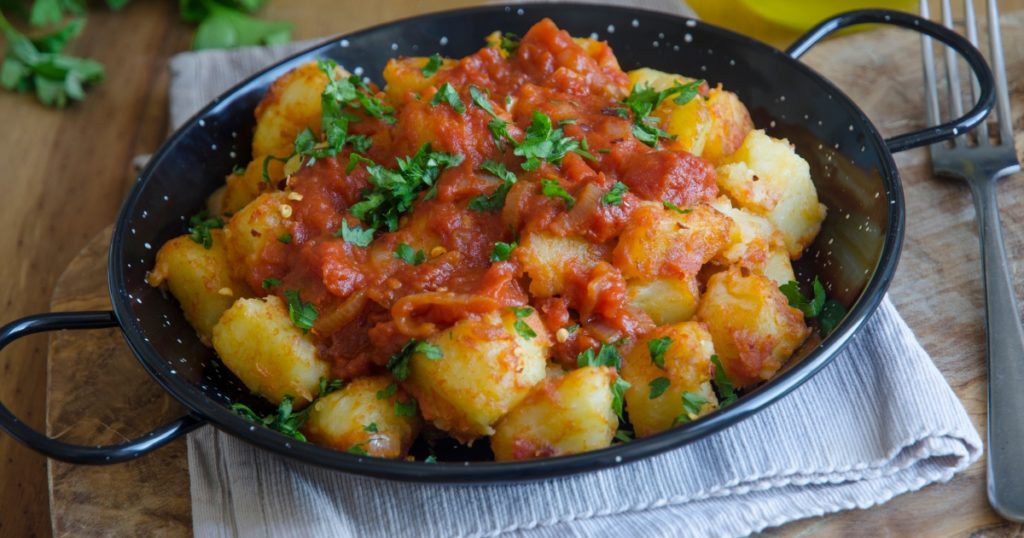
Conclude your emotional culinary journey with Salmorejo, a velvety symphony of tomatoes. This chilled soup, rich in flavor and history, provides a refreshing and satisfying finale to your exploration of Spanish tapas.
Want to make Spanish Tapas at the comfort of your home?
Thinking about making Spanish Tapas at home? It’s a great idea! Tapas are perfect for a relaxed get-together since they’re easy to make. Everyone can try different tasty dishes without you spending too much or making too much food.
So, why not bring the fun and flavor of Spanish tapas to your own kitchen?
If you’re wondering how to do that, well, we have some good news for you: we have a class by Chef Him Uy De Baron at The Bailiwick Academy that can help you do this. Its name?
In this easy-to-follow class by Chef Him, you can easily dive into the world of Spanish cuisine and learn his versions of some classic Spanish recipes:
- Spinach and Jamón Croquetas: golden bites with a crispy outside and a creamy mix of béchamel, spinach, and ham inside.
- Tortilla de Patata con Chorizo: a hearty Spanish omelette packed with thinly sliced potatoes and spicy chorizo sausage—it’s full of flavor!
- Fideua con Mariscos: similar to paella but with short noodles, this dish combines perfectly cooked noodles with a variety of fresh seafood
- Sangria: this refreshing drink is the perfect pairing for your tapas spread
With clear steps for ingredient identification and cooking procedures, even beginners can create these delicious dishes. Get ready to enjoy a taste of Spain right at home: sign up at The Bailiwick Academy today!
—
Keep coming back to The Bailiwick Academy blog for more baking and cooking tips, kitchen tricks, and much more!
]]>Why make and give edible Christmas gifts?
Christmas food gifts are a thoughtful, inclusive, and delicious way to create lasting holiday memories and spread cheer. By investing time and care into baking or creating a culinary treat, you showcase your skills and creativity, making each gift a unique expression of affection. These gifts are delightful to receive, won’t contribute to clutter, and can be customized to suit individual tastes and dietary needs.
Convinced? Great! Now, if you’re wondering, “What can I make as Christmas gifts?”, well, we’ve got you!
On to the seven ideas!
Edible Christmas Gift Ideas To Make 1: Homemade Cookies

Homemade cookies are a timeless and delightful choice as one of your choices for Christmas gift ideas. You can make different flavors and styles that will suit everyone’s taste. It doesn’t have to be holiday-themed either, like gingerbread men or cookies shaped into candy canes—classic cookie shapes and flavors like chocolate chip cookies will do.
But if you want to keep with the season, pack them in decorative tins or cellophane bags tied with festive ribbons. And there, you have an easy, DIY gift of Christmas cookies!
Thinking of what cookies to make? Choose from these classes here at The Bailiwick Academy: Gourmet Cookies by Chef Bam Piencenaves, Best Ever Cookies by Chef Joey Prats, and Unique Cookie Concepts by Chef Miko Aspiras.
Edible Christmas Gift Ideas To Make 2: Polvoron In A Jar
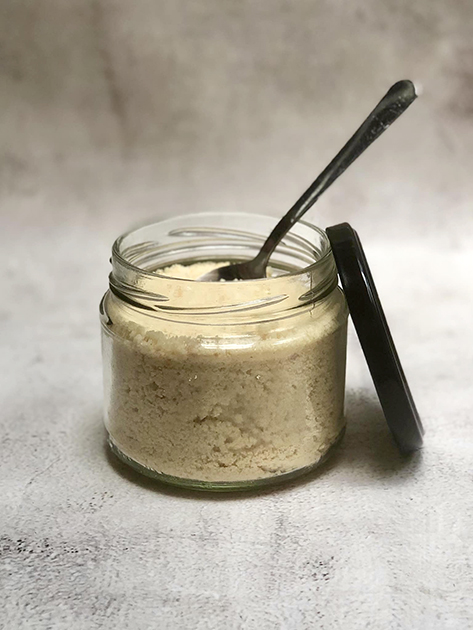
Polvoron traditionally is eaten molded into shapes, but why not give your loved ones something different? For this holiday season, surprise your loved ones with a creative twist on this classic delicacy by presenting the polvoron powder in mason jars. You can add a spoon so that they can eat out of the jar, but you can also attach instructions on how to mix and mold the polvoron, turning these edible gifts into a cute, delightful activity.
Looking for the best polvoron recipe possible? Check out Chef Miko Aspiras’ Madrid Fusiòn Polvoron class.
Edible Christmas Gift Ideas To Make 3: Cakes In Cans

Cakes in cans are a fun and unique edible gift idea for Christmas. Simply bake your favorite cake dessert recipes in a clean, empty can, and you’ve got a portable and delightful item great for Christmas gifting. You have the freedom to choose any cake recipe you like, from chocolate fudge to white chocolate to fruitcake.
Once baked and cooled, you can decorate the can with ribbons or stickers and add a little note to make it personal. This DIY gift is not only tasty but also shows your creative side.
Want to give these as gifts during the festive season? Check out Chef Joey Prats’ The Cake Cannery class or Ms. Chiqui Ortiz-Dingcong’s Keto Cheesecakes class for sugar-free, guilt-free options.
Edible Christmas Gift Ideas To Make 4: Pie

Homemade pie is a heartwarming gift that brings comfort and joy during the holiday season. Whether it’s a classic apple pie or every Pinoy’s favorite pasalubong, buko pie, it’s sure to be a hit. Bake it in a disposable pie tin, let it cool, and then wrap it up with some festive wrapping or place it in a pie box.
Add a little tag with a sweet message or the recipe, and your delicious, thoughtful food gifts are ready to go!
Looking for an easy recipe to make pies? Check out Chef Jimbo de Panadero’s Bakery-Style Buko Pie class or Chef Joey Prats’ Fabulous Pies class.
Edible Christmas Gift Ideas To Make 5: Savory Treats In Jars

Not everyone has a sweet tooth, and that’s where savory treats in jars come in handy. You can layer ingredients for a soup mix, create a homemade spice blend, or even jar up some chili oil, marinated olives or feta. These edible Christmas gifts in a jar are not only tasty but also show that you’ve put thought into catering to different tastes.
It’s definitely a great way to introduce friends and family to new flavors and recipes—and are great for business way after the holiday season.
To get more specific, you can:
- Enroll in Gourmet in a Bottle by Chef Chona Garcia-Laureta for some long-lasting, gourmet fish treats;
- Get Chef Allan Mertola’s recipe for Chili Garlic Sauce in his Dimsum 101 class, which we’ve heard are best-sellers for plenty of Bailiwickers; or
- Take Chef RV Manabat’s All-Natural Meat Processing class and learn his recipe for preservative-free Garlic Atsara, which, as we all know, is enjoyed by many Pinoys!
Edible Christmas Gift Ideas To Make 6: Christmas Ham

A Christmas ham is already a popular Christmas gift idea here in the Philippines, so why not make your own for a really perfect gift? You can be sure that receivers will appreciate this homemade edible gift, especially during family dinners for the holiday season.
And if you want to make some of the best hams ever, enroll in Sir Rodney Martinez’ Delicious Glazed Hams class. Make two kinds of hams and glazes that will take your loved ones’ ham experience to the next level!
Edible Christmas Gift Ideas To Make 7: Chocolate Truffles

Chocolate truffles are luxurious and decadent homemade Christmas gifts, perfect for those who appreciate the finer things in life. You can make them at home using good quality chocolate, cream, and a bit of butter, then roll them in cocoa powder, chopped nuts, or coconut flakes. Place them in a small box or cellophane bag tied with a ribbon, and you have an elegant gift ready to go.
And believe us, when you give these as gifts for friends, they will love you for life! After all, chocolate truffles are not just a gift; they’re an experience, rich and full of flavor. When you taste your creation, this homemade gift might not make it to your loved ones—they’re that good!
Speaking Of Chocolate Truffles…
If you’re on the hunt for a treat that’s both easy to make and irresistibly delicious, you’ve hit the jackpot! Check out Chef Chona Garcia Laureta’s class: Chocolate Cookie Truffles!
Enroll in this class and get an easy recipe for no-bake Chocolate Cookie Truffles! Imagine biting into a glossy chocolate shell and finding a velvety, melt-in-your-mouth center – that’s exactly what these truffles offer. They’ll strike the perfect balance between simplicity and indulgence, and are suitable for any occasion, making them a versatile gift option, not just during the holidays.
Ready to dive in? Sign up at The Bailiwick Academy today to start making these homemade food gifts! They’re simple but decadently delicious treats that are sure to impress!
Final Thoughts
We hope you found one you want to try from this list of edible Christmas gift ideas to make! This holiday season, let your loved ones know just how much you care with thoughtful, homemade gifts. From sweet to savory, there’s a delightful option for everyone.
Get creative, personalize your gifts, and embrace the joy of giving. Happy holidays!
—
Keep coming back to The Bailiwick Academy blog for more baking and cooking tips, kitchen tricks, and much more!
]]>What’s Cake Fiesta Manila 2023 all about?
Cake Fiesta Manila is not just any cake show. It’s the FIRST in the Philippines and the BIGGEST International Cake Show in Asia! With numerous global cake shows happening all over, the founders and organizers Valeri & Christina of Queen of Hearts Couture Cakes and Penk Ching of Pastry Bin wanted to establish one in the Philippines, which they started in 2019.
Cake Fiesta Manila’s mission is to uplift the standards of cake decorating in Asia by collaborating with top-tier suppliers and inviting the best instructors globally. The cake competitions are designed to spotlight and challenge the emerging talents in the cake world.
Cake Fiest Manila 2023 Happenings
This year promises even more excitement with the following:
Competitions: Open to everyone, from beginners to pros. Showcase your cake-decorating prowess and aim for that coveted GOLD medal!
Workshops: Learn from the BEST local and international cake artists. These hands-on workshops are a golden opportunity to refine your skills. But be quick to sign up; slots fill up fast!
Demos: Choose from a plethora of cake decorating topics presented by the world’s leading Cake Artists. Each 45-minute demo is packed with invaluable insights, tips, and tricks.
Vendors: Discover the best brands in the cake and bake industry. Ready your wallets for exclusive deals, especially from international vendors, saving you those hefty shipping costs!
Teachers: From buttercream to fondant, chocolate to sugar flowers, and much more. The best teachers are lined up to impart their knowledge.
Cake Wars: Witness the ULTIMATE Cake Decorating battle! Teams, including individuals, cake groups, schools, and even kids, will compete LIVE for the title and trophy.
Bake Bazaar: There will be a dedicated section for talented bakers to display and sell their delectable creations. Perfect for indulging or gifting!
Book Signings: Get your cake books autographed by renowned authors and snap a photo with them. Meet and Greet sessions with founders Valeri Valeriano and Christina Ong of Queen of Hearts Couture Cakes (also TBA instructors), co-founder Penk Ching, and other celebrated artists are on the cards.
Make and Take: Partnered with Maya, this feature allows attendees to craft under the guidance of talented teachers. Not only do you take home new skills, but also the treats you craft!
The Bailiwick Academy’s Role in Cake Fiesta Manila 2023
Cake Fiesta Manila 2022 was a fun one for me, the TBA team, and the Bailiwickers who attended. Check out these posts!



As you can see, not only did they get to participate in some of activities at Cake Fiesta Manila, they also got to meet some of their beloved chef instructors like Chef Bam Piencenaves, Chef Max Nadin, Chef Allan Mertola, Chef Chona Garcia Laureta, Chef Ely Salar, Sir Amir Valdez, Chef Marc Kevin Reyes, Sir Rodney Martinez, and Sir Joey Montanez!
Last year, we also organized a big meet and greet for Bailiwickers at our booth. That helped me meet a lot of Bailiwickers for the first time—something I really appreciated!
That’s not all—last year, I offered prizes to people who would visit our booth. For people who signed up, they got Php500 and Php250 vouchers for classes, while existing students got a 25% if they enrolled in a class in our booth. Everyone who dropped by also got the chance to win a special prize by playing a mini-game or by posting on social media.
We also had chefs doing demos in our booth back in 2019 and in 2022.
What do we have in store for people who visit booth E04 this year? Well, just wait and see! Sign up at The Bailiwick Academy to join our email list and get the latest updates.
Also, make sure you’re part of the TBA Student Lounge and that you’re following us on Facebook and be ready for our announcement of activities. I promise you won’t be disappointed!
How can you join Cake Fiesta Manila 2023?
Securing your spot is a breeze. Grab your tickets online for Cake Fiesta Manila 2023. Multiple ticketing options cater to everyone, whether you’re planning to attend a single day or immerse yourself in all the days..
VIP Ticket
If you want a special experience, grab the VIP ticket for Php2500. This includes access for all event days, fast track entries, front row seats, access to the VIP Lounge with complimentary refreshments, plenty of freebies, exclusive VIP goodies, and much more.
However, tickets are limited to only 100 buyers, so make sure you buy before you run out of tickets!
Regular Admission
You also have the option for regular tickets for only Php200 a day. For more details about the inclusions, just email the Cake Fiesta Manila team at [email protected].
Wrapping It Up
Again, I hope to see you at booth E04 at Cake Fiesta Manila 2023. We’ll be there from November 16-19, 2023 at the SMX Convention Center in Pasay City. Remember: Function Rooms 3 and 4 is the place to be!
And don’t forget: wait for our email or the announcements on our social media pages to find out what we have in store for you when you attend!
I’m eager to meet you, whether once again or for the first time. Get your tickets now and see you then!
—
Keep coming back to The Bailiwick Academy blog for more baking and cooking tips, kitchen tricks, and much more!
]]>

 (@hawaiifoodreviews)
(@hawaiifoodreviews)